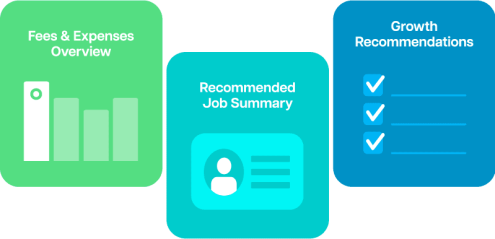Headless Commerce vs Traditional Platforms: Which is Right for Your Business?
Terrence Roice Ignacio
on
March 18, 2025
Customer demands continuously evolve. Along with it, their buying habits. And with so many e-commerce stores out there, the control is theirs.
What does that mean for merchants? Online stores need to step up and make sure that customers get what they want the way they want it. Headless commerce can help business owners do that.
Headless commerce is simply the separation of the front-end elements from the back-end infrastructure, which provides more flexibility in improving the customer experience on the app or website. But is this right for your business? And how does it compare to traditional platforms?
In this blog, we will examine the main distinctions between headless and conventional platforms; reveal which option best fits your business and emphasise how outsourcing roles via Staff Domain can streamline the overall process.
Headless Commerce: What Is It and How Does It Work?

Headless commerce is an e-commerce architecture that separates the two major elements: front-end (visual elements and overall layout of a website or app) and back-end (systems and processes that deal with inventory, payments, integrations, etc.).
This separation (or ‘decoupling’) allows merchants to perform modifications on the front-end with less restrictions, which is usually not the case with traditional architectures, where the front-end and back-end are part of one infrastructure.
With headless commerce, app developers can easily change the layout of the app by adding interactive elements or enhancing the visuals to make it more appealing to users. These enhancements can get more people to buy. And since the front-end is separated from the back-end, developers will be able to perform these changes with ease—and, more importantly, without the need to tweak any back-end functionality
In a headless configuration, companies have the freedom to improve any front-end element while the back-end stays consistent. With these enhancements, business owners can be confident that the quality of user experience is maintained.
How Does Headless Commerce Work?
Headless platforms depend on Application Programming Interfaces (APIs) to link the front-end to the back-end. These APIs act as ‘messengers’ and enable smooth data transfer so that the e-commerce store can maintain a reliable connection between the front-end and back-end.
For example, when a customer clicks on a product, the API pulls the most recent product data from the back-end and displays it on the front-end (the screen)–quickly. If the user makes a payment, the API send this information to the payment system and then automatically updates the inventory.
On the other hand, if business owners decide to add new element on the website or integrate to other platforms—like sell directly on Tiktok or Instagram—they can easily do so.
Benefits of Headless Commerce
- Customised user experience: Design distinctive storefronts customised for the target audience.
- Quicker innovation: Evaluate and introduce new features without affecting the back-end.
- Omnichannel selling: Integrate effortlessly to different platforms, like social media, to get more reach for more opportunities for sales.
- Scalability: Seamlessly adjust to traffic surges, emerging markets, and changing business requirements.
- Enhanced performance: Quicker loading times and a more seamless shopping experience for buyers.
Is Headless Commerce Right for You?
Although headless commerce provides unparalleled flexibility, it requires technical skills for implementation and management. Companies with internal development teams or external support—like those from Staff Domain—can utilise headless platforms efficiently. Conversely, smaller companies with restricted technical resources may perceive conventional platforms as easier to handle.
Traditional E-Commerce Platforms: Structure, Benefits, and Limitations

Although headless commerce provides flexibility, conventional e-commerce platforms are still a favoured option for numerous businesses because of their ease of use and comprehensive design. Platforms such as Shopify, WooCommerce, and BigCommerce merge the front-end (storefront) and back-end (inventory, orders, and content management) into one cohesive system.
All aspects, including product updates and website design, are handled on a single platform, simplifying the process for businesses with restricted technical resources to create and uphold an online store. Nonetheless, this ease frequently sacrifices customisation and scalability.
How Traditional E-Commerce Platforms Work
Conventional platforms employ a monolithic structure, in which the front-end and back-end are closely interconnected. Modifications to the user interface typically need alterations to the back-end, and vice versa.
For instance, tweaking a product page design often requires changes to both the layout and the underlying data structure. This configuration makes management easier, but it may restrict flexibility when branching out to new sales channels or adding custom features.
Benefits of Traditional E-Commerce Platforms
- Easy setup: Many platforms provide drag-and-drop interfaces and ready-made templates.
- Budget-friendly: Reduced initial expenses in comparison to headless solutions.
- Unified dashboard: Oversee products, content, and orders from a single location.
- Integrated functions: Numerous platforms offer marketing tools, payment gateways, and analytics.
- Rapid launch: Faster to initiate; particularly beneficial for small to medium enterprises.
Limitations of Traditional Platforms
- Restricted customisation: Templates of the platform frequently constrain design and features.
- Performance limitations: Websites may experience slower speeds as the range of products and user traffic increases.
- Complex multi-channel integration: Growing into mobile applications, marketplaces, or different digital interactions can be intricate.
- Hard to scale: As your business expands, enhancing features or managing significant traffic surges may require transitioning to a more adaptable solution.
Is a Traditional Platform Right for You?
Conventional platforms are perfect for startups, small enterprises, or brands with simple e-commerce requirements. They offer an affordable method to go online swiftly without needing extensive technical knowledge. Nonetheless, if your goal is to achieve a highly tailored, multi-channel experience, considering headless commerce could be a wiser long-term investment.
Key Differences Between Headless and Traditional E-Commerce

Choosing between headless commerce and traditional platforms comes down to how much control, flexibility, and scalability your business needs. While traditional platforms offer convenience through an all-in-one solution, headless platforms provide greater freedom to customise and innovate.
Here is a detailed examination of the main distinctions between the two methods.
1. Architecture and Flexibility
- Headless commerce: The user experience (front-end) is separated from the back-end (content, product, and order management). This division enables developers to utilise any technology for the storefront while maintaining stability in the back-end.
- Traditional platforms: The front-end and back-end are closely connected. Modifications to the user interface typically need changes to the back-end, which restricts design adaptability.
2. Customisation and User Experience
- Headless commerce: Developers are able to create fully tailored storefronts, offering distinctive user experiences on websites, mobile applications, and even smart gadgets.
- Traditional platforms: Personalisation is restricted to the templates and themes provided by the platform. Complex modifications often need plugins or alternative solutions.
3. Speed and Performance
- Headless commerce: By independently optimising the front-end, websites can have quicker load times and enhanced performance.
- Traditional platforms: As traffic and product inventories expand, conventional platforms may become less efficient and affect user experience.
4. Cost and Development Time
- Headless commerce: Although headless systems provide lasting adaptability, they usually require greater initial development expenses and extended implementation periods.
- Conventional platforms: Conventional options tend to be less expensive and faster to implement, which makes them suitable for small to mid-sized enterprises.
5. Multi-Channel Selling
- Headless commerce: Companies can expand into additional sales channels, like mobile applications, marketplaces, and digital displays in stores without much difficulty.
- Conventional platforms: Integrating multiple channels can be difficult, frequently requiring third-party applications or bespoke development.
Ultimately, headless commerce is ideal for brands looking for enhanced personalisation, scalability, and a presence across multiple channels. Conversely, conventional platforms provide ease of use and cost-effectiveness, making them suitable for companies with basic e-commerce requirements.
Which E-Commerce Approach Is Right for Your Business?

Choosing between headless commerce and conventional platforms depends on your business objectives, technical capabilities, and future aspirations. Although both methods facilitate online sales, discrepancies in flexibility, scalability, and cost may greatly affect your operations.
Here’s how to determine which solution suits your business best.
1. Business Size and Stage
- Headless commerce: Perfect for businesses aiming to scale, tailor customer experiences, and expand by integrating to various sales channels.
- Traditional platforms: Ideal for startups and small enterprises seeking a fast, affordable method to establish an online store without requiring advanced technical skills.
2. Technical Resources
- Headless commerce: Requires experienced developers to create, oversee, and upkeep the system. Numerous companies delegate these positions to agencies or staffing partners such as Staff Domain.
- Traditional platforms: Simpler to handle with integrated tools and intuitive dashboards. Daily operations do not require any advanced coding skills.
3. Technical Resources
- Headless commerce: Provides complete authority over the front-end, facilitating distinctive, brand-tailored user interactions on websites, applications, and various digital platforms.
- Traditional platforms: Personalisation is restricted to the templates and plugins offered by the platform.
4. Cost and Time Investment
- Headless commerce: Initial expenses are greater because of tailored development, yet it proves to be more economical over time for companies looking to grow.
- Traditional platforms: Reduced upfront expenses and quicker deployment, although scaling could necessitate a transition to a more adaptable system.
5. Future Growth and Multi-Channel Expansion
- Headless commerce: Perfect for companies looking to grow into mobile applications, marketplaces, or global markets while ensuring a uniform shopping experience.
- Conventional platforms: Appropriate for companies primarily concentrating on online sales without intricate multi-channel needs.
Headless commerce is the ideal option if your priorities include flexibility, customisation, and sustainable growth. On the other hand, traditional platforms are ideal for companies looking for a straightforward, cost-effective, and manageable option.
Outsourcing Key E-Commerce Roles with Staff Domain
Regardless of whether you’re utilising headless commerce or a conventional platform, delegating essential positions to Staff Domain can enhance operations, lower expenses, and increase efficiency.
Key Roles to Outsource:
- E-Commerce Developers: Build custom front-end for headless platforms or optimise traditional sites.
- UX/UI Designers: Create seamless, user-friendly shopping experiences across devices.
- Digital Marketing Specialists: Drive traffic through SEO, paid ads, and social media.
- Content Managers: Maintain consistent product listings, blogs, and promotions.
- Customer Support Teams: Handle enquiries, returns, and order updates.
Outsourcing these positions guarantees specialised assistance without the costs of internal recruitment, facilitating the efficient growth of your e-commerce enterprise.
Staff Domain’s offshore outsourcing solutions connect your business to a highly experienced global talent pool for game-changing results. Manage your offshore workforce effortlessly with our comprehensive compliance, payroll, and HR support, and benefit from fixed, transparent pricing in your local currency. Contact us today or schedule a meeting with our Sales team to quickly source the right offshore team for your business.
Future Trends in Headless and Traditional Commerce
- Omnichannel experiences: Headless platforms will spearhead the provision of effortless shopping across websites, mobile applications, marketplaces, and smart devices.
- Personalisation on a large scale: Companies utilising headless architecture can harness sophisticated customer data to craft extremely tailored shopping experiences.
- Enhanced site speed: Headless systems will keep optimising loading times, improving user engagement and increasing conversion rates.
- AI-enhanced shopping: With customised product suggestions and automated support, AI will increasingly influence both headless and conventional e-commerce.
- Sustainable and scalable solutions: As businesses grow, headless platforms will offer more eco-friendly, scalable options compared to monolithic systems.
Conclusion: Making the Right E-Commerce Choice
Selecting between headless commerce and conventional platforms ultimately relies on your business requirements, resources, and expansion objectives. Headless commerce provides unparalleled flexibility, customisation, and multi-channel selling—perfect for brands looking to grow and innovate.
Regardless of your choice, outsourcing critical positions via Staff Domain can simplify your operations, guaranteeing you possess the necessary expertise to thrive. By utilising the appropriate platform and having support available, your business can provide exceptional shopping experiences and remain competitive in the evolving e-commerce environment.
FAQs: Headless E-Commerce vs Traditional Platforms
1. What is headless commerce, and how does it work?
Headless commerce separates the front-end (storefront) from the back-end (product and order management). They connect via APIs, allowing more customisation and flexibility in the user experience.
2. What are the main advantages of headless commerce?
Headless commerce offers greater customisation, faster site performance, and seamless multi-channel selling. It also allows businesses to update front-end experiences without affecting back-end operations.
3. Is headless commerce more expensive than traditional platforms?
While headless commerce typically has higher upfront development costs, it can be more cost-effective in the long run for growing businesses due to its scalability and flexibility.
4. Which e-commerce platform is better for small businesses?
Traditional platforms are often better for small businesses due to their affordability, user-friendly setup, and built-in features. However, headless commerce is ideal for businesses aiming to scale or offer unique user experiences.






































